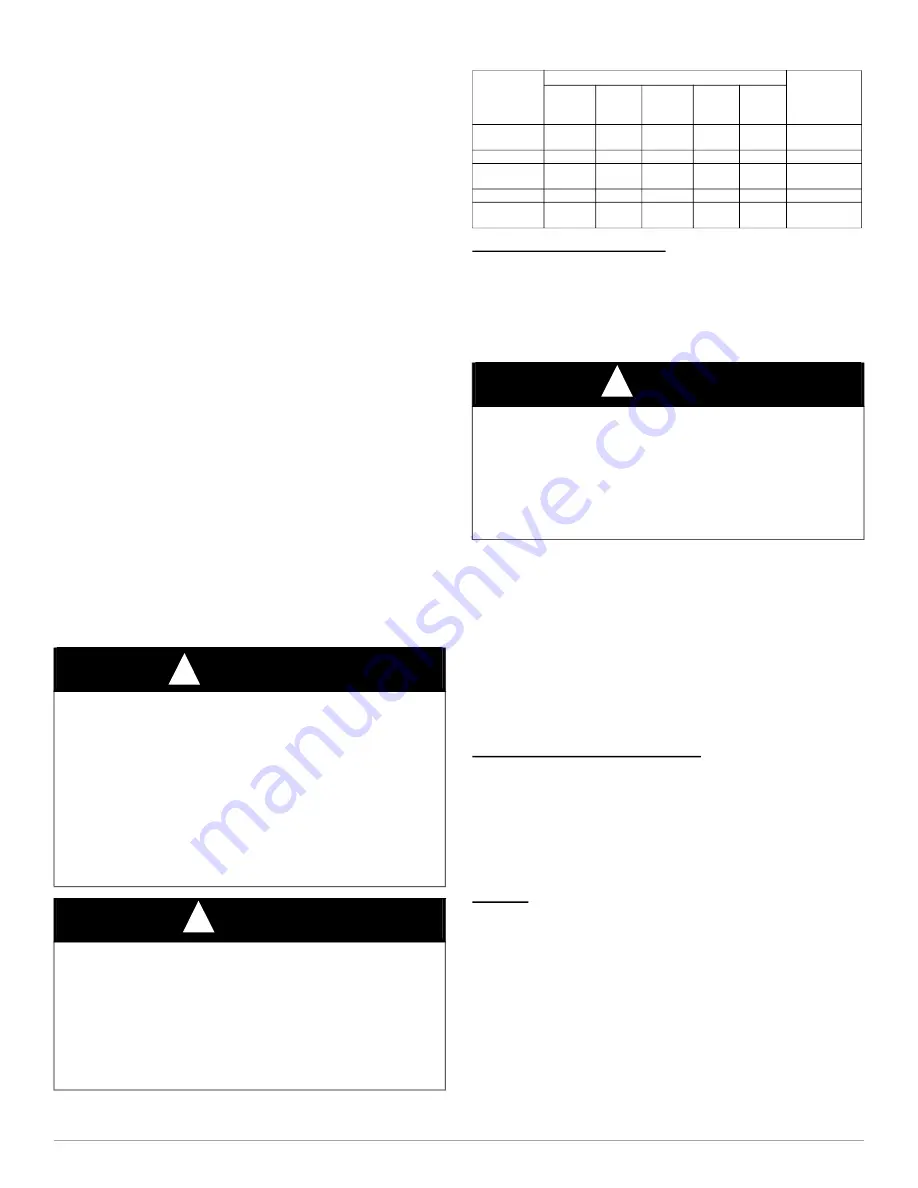
59CU5A: Installation, Start-up, Operating and Service and Maintenance Instructions
Manufacturer reserves the right to change, at any time, specifications and designs without notice and without obligations.
32
need to be re-sized. Vent systems or vent connectors of other appliances
must be sized to the minimum size as determined using appropriate table
found in the current edition of National Fuel Gas Code NFPA 54/ANSI
Z-223.1.
An abandoned masonry chimney may be used as a raceway for properly
insulated and supported combustion-air (when applicable) and vent
pipes. Each furnace must have its own set of combustion-air and vent
pipes and be terminated individually for Direct Vent (2-Pipe) system, see
, for single-pipe or ventilated combustion air option, see
.
A furnace shall not be connected to a chimney flue serving a separate
appliance designed to burn solid fuel.
Other gas appliances with their own venting system may also use the
abandoned chimney as a raceway providing it is permitted by local code,
the current edition of the National Fuel Gas Code, and the vent or liner
manufacturer’s installation instructions. Care must be taken to prevent
the exhaust gases from one appliance from contaminating the
combustion air of other gas appliances.
Do not take combustion air from inside the chimney when using
ventilated combustion air or single-pipe vent option.
These furnaces can be vented as direct-vent (two-pipe), ventilated
combustion air or non-direct (single-pipe) vent system. Each type of
venting system is described below. Common venting between these
furnaces or other appliances is prohibited.
Materials
Combustion air and vent pipe, fittings, primers, and solvents must
conform to American National Standards Institute (ANSI) standards and
American Society for Testing and Materials (ASTM) standards. For
approved materials for use in the U.S.A., see
. This furnace is
also CSA approved for venting with M&G DuraVent
R
PolyPro
R
polypropylene venting systems.
NOTE:
When using polypropylene venting systems, all venting
materials used, including the vent terminations must be from the same
manufacturer.
Venting Systems
RECOMMENDED SUPPORT FOR
Table 14 – Vent Termination Kit for Direct Vent (2-pipe) Systems
Direct Vent / 2-Pipe System
In a direct-vent (2-pipe) system, all air for combustion is taken directly
from outdoor atmosphere, and all flue products are discharged to outdoor
atmosphere. Combustion-air and vent pipes must terminate together in
the same atmospheric pressure zone, either through the roof (preferred)
or a sidewall. For references to clearances required by National code
authorities, see
OPTIONAL CONFIGURATION FOR COMBUSTION
Ventilated Combustion Air Systems
In a ventilated combustion air option, the vent terminates and discharges
the flue products directly to the outdoors similar to a direct vent system.
References to clearances required by National code authorities, see
All air for combustion is piped directly to the furnace from a space that is
well ventilated with outdoor air (such as an attic or crawl space) and the
space is well isolated from the living space or garage. Combustion air
requirements for this option are the same as the requirements for
providing outside air for combustion for a single pipe vent system. Refer
to the “Air For Combustion and Ventilation” Section.
Non-Direct Vent (1-pipe) System
In a non direct-vent (1-pipe) system, all air for combustion is taken from
the area adjacent to furnace, and all flue products are discharged to
outdoor atmosphere. Air for combustion must be supplied as described
in the Air For Combustion and Ventilation Section. Do not use an
abandoned chimney to supply outside air to the furnace. References to
vent clearances required by National code authorities, see
Locating the Vent Termination
General
Combustion-air inlet pipe (direct vent/2-pipe system only) and vent pipe
must terminate outside structure, either through sidewall or roof.
Special termination requirements may be required in other Canadian
provinces. Refer to the authority having jurisdiction for clarification
and/or additional clearance requirements.
WARNING
!
CARBON MONOXIDE POISONING HAZARD
Failure to follow the instructions outlined below for each appliance
being placed into operation could result in carbon monoxide poisoning
or death.
For all venting configurations for this appliance and other gas
appliances placed into operation for this structure, provisions for
adequate combustion, ventilation, and dilution air must be provided in
accordance with:
Current edition of
Section 9.3 NFPA 54/ANSI Z223.1, Air for
Combustion and Ventilation and applicable provisions of the local
building codes.
NOTICE
!
VENT TERMINATION
It is recommended that sidewall vent terminations of over 24 inches
(0.6 M) in length or rooftop vent terminations of over 36 inches (1 M)
in length be supported by EITHER the factory accessory vent termina
-
tion kit or field-supplied brackets or supports attached to the structure.
A factory accessory vent termination kit may be used for direct vent ter
-
minations. Termination kits are available for 2-in. or 3-in. pipe. For
available options, see
Vent and
Combustion
Air Pipe
Diameters
Approved Two-Pipe Termination Fittings
Allowable
Concentric
Vent Kit
1 1/2-in.
(38 mm)
2-in.
(51
mm)
2 1/2-in.
(64 mm)
3-in.
(76
mm)
4-in.
(102
mm)
1 1/2-in. (38
mm)
No
Yes
No
No
No
2-in. (51 mm)
2-in. (51 mm)
No
Yes
No
No
No
2-in. (51 mm)
2 1/2-in. (64
mm)
No
No
No
Yes
No
2-in. (51 mm)
3-in. (76 mm)
3-in. (76-mm)
No
No
No
Yes
No
3-in. (76 mm)
4-in. (102
mm)
No
No
No
Yes
Yes
3-in. (76 mm)
NOTICE
!
AIR INLET PIPE
In applications where there is a risk of excessive moisture entering the
combustion air inlet pipe, a moisture trap may be added to the inlet pipe
to help prevent moisture from entering the furnace from the combustion
air inlet pipe, see
.
When sizing venting systems, the equivalent length of the optional inlet
pipe moisture trap must be taken into account.
















































